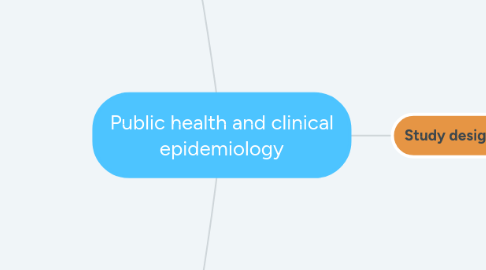
1. AAAA- Systematic reviews
1.1. Advantages
1.1.1. More than one study addressing a question
1.1.2. Efficient way to examine evidnece
1.1.3. Greater precision if results
1.1.4. Identify missing information for primary research
1.2. Problems with RCTs
1.2.1. Chance
1.2.2. Difference in people
1.2.3. Differences in care
1.2.4. Differences in way treatment effects are measured
1.2.5. Differences to follow up
1.2.6. Publication bias
1.2.6.1. Positive reporting bias
1.2.6.1.1. Authors more likely to submit and editors more likely to publish
1.2.6.2. Outcome reporting bias
1.2.6.2.1. Several outcomes within a trial are measured but reported selective
1.2.7. Volume of literature
1.2.7.1. Low quality drowns out high quality
1.3. Method used to synthesise multiple research evidence on the effectiveness of treatment
1.3.1. Follows AAAA
1.4. Systematic review vs meta analysis
1.4.1. Systematic review
1.4.1.1. Explicit methods to identify and review all research on a topic
1.4.2. Meta analysis
1.4.2.1. Statistical techniques combine quantitative results from multiple studies
1.5. Critical appraisal questions
1.5.1. Clearly focused question?
1.5.2. Right type of study?
1.5.3. All relevant studies?
1.5.4. How did they decide what studies were relevant and assess the quality?
1.5.5. Was it appropriate to combine results?
1.5.6. How was the result presented?
1.5.7. Was it precise?
1.5.8. Can the results be applied to general population
1.5.9. All important outcomes considered?
1.5.10. Policy change?
2. AAAA- Therapy
2.1. Effectiveness, diagnosis, frequency, prognosis
2.2. Assess
2.2.1. PICO clear clinical question
2.2.2. Identify best study design
2.3. Access
2.3.1. Search for and find relevant evidnece
2.3.2. Cochrane library
2.3.3. Midline, pubmed
2.4. Apprise
2.4.1. Does it answer the question
2.4.2. Randomisation
2.4.3. Concealment
2.4.4. Similar groups at start of study
2.4.5. Patients analysed via intention to treat
2.4.6. Complete follow up
2.4.7. Outcomes measured blind
2.4.8. Understand results
2.5. Act
2.5.1. Apply the evidnece
2.5.1.1. Limitations
2.6. Bias
2.6.1. Selection
2.6.1.1. Patient preferences
2.6.1.2. Selection to study not random
2.6.2. Allocation
2.6.2.1. Knowing who's in each group
2.6.3. Attrition
2.6.3.1. Caused by uneven dropping out
2.7. Interpretation of results
2.7.1. RR
2.7.1.1. risk of intervention/ risk of comparator
2.7.1.1.1. RR=0
2.7.1.1.2. Outcomes in treatment group vs comparator group
2.7.2. IR
2.7.2.1. +ve outcomes/total participants
2.7.3. RD
2.7.3.1. Risk of intervention-risk of compartor
2.7.3.1.1. RD= 0
2.7.3.1.2. Risk of outcome in treatment group vs the comparator group
2.7.4. NNT
2.7.4.1. 1/RD
2.7.4.2. Number of patients needed to treat to obtain 1 additional beneficial outcome compared with the comparator group
3. Study designs for helathcare
3.1. AAAA
3.1.1. Framework of evidence based medicine
3.1.1.1. Why important
3.1.1.1.1. Mid cal knowledge changing
3.1.1.1.2. Doctors fail to use best treatment
3.1.1.1.3. Keeping up to date commitment
3.1.1.2. Cot deaths
3.1.1.2.1. Front sleeping recommended UK 1970s
3.1.1.2.2. Case control studies showed no benefit
3.1.1.2.3. Combined they showed harm
3.1.1.3. Thalidomide
3.1.1.3.1. Given to F 3 months pregnant
3.1.1.3.2. 🇩🇪 + 🇦🇺 doctors 1961 made link
3.1.1.3.3. Epidemic of birth defects and early do mortality
3.1.2. Assess
3.1.3. Access
3.1.4. Appraise
3.1.5. Act
3.2. Types of study
3.2.1. Descrpitive
3.2.1.1. Population level
3.2.1.1.1. Ecological
3.2.1.2. Individual
3.2.1.2.1. Cross-sectional
3.2.1.2.2. Case report/series
3.2.2. Analytical
3.2.2.1. Observational
3.2.2.1.1. Case control
3.2.2.1.2. Cohort
3.2.2.2. Intervention
3.2.2.2.1. RCT
3.2.3. Qualitative
3.2.3.1. Explores peoples subjective understanding of their lives and experiences
3.2.3.2. Direct observation, interviews, focus groups
3.2.3.3. Patient and healthcare provider experience
3.3. Hierarchy of evidence
3.3.1. RCT, Cohort, Case control, Case series/report, expert opinion
